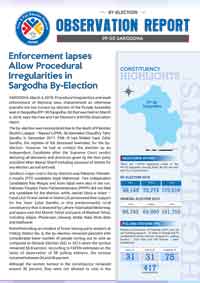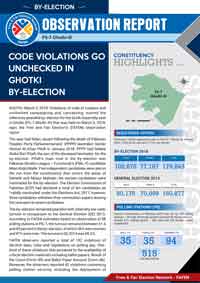SARGODHA, March 4, 2018: Procedural irregularities and weak enforcement of electoral laws characterized an otherwise peaceful but low turnout by-election of the Punjab Assembly seat in Sargodha (PP-30 Sargodha-III) that was held on March 4, 2018, says the Free and Fair Election’s (FAFEN) observation report.
The by-election was necessitated due to the death of Pakistan Muslim League – Nawaz’s (PML-N) lawmaker Chaudhry Tahir Sandhu in December 2017. PML-N had fielded Yasir Zafar Sandhu, the nephew of the deceased lawmaker, for the by-election. However, he had to contest the election as an Independent Candidate after the Supreme Court verdict declaring all decisions and directives given by the then party president Mian Nawaz Sharif including issuance of tickets for any election, as null and void.
Sandhu’s major rival in the by-election was Pakistan Tehreek-e-Insaf’s (PTI) candidate Sajid Mahmood. Two Independent Candidates Rao Waqas and Asim Iqbal were also in the run. Pakistan Peoples Party Parliamentarians (PPPP) did not field any candidate for the election, while Jamiat Ulma-e-Islam – Fazal (JUI-F) and Jamat-e-Islami (JI) announced their support for the Yasir Zafar Sandhu in this predominantly rural constituency that is bisected by Lahore-Islamabad Motorway, and spans over Kot Momin Tehsil and parts of Bhalwal Tehsil, including Salam, Phularwan, Deowal, Abdal, Nabi Shah Bala and Sadhuwal.
Notwithstanding an incident of brawl among party workers at Polling Station No. 6, the by-election remained peaceful with considerably lower number of people turning out to vote as compared to General Election (GE) in 2013 when the turnout remained 58.8 percent. According to FAFEN estimates on the basis of observation of 98 polling stations, the turnout remained between 34 and 36 percent.
Although the women turnout in the constituency remained around 30 percent, they were not allowed to vote in the Chaowal neighborhood of the constituency. According to FAFEN observers, only one of a total of 748 registered voters casted her vote until 4:15 pm at Polling Station No. 94 (Government Boys Middle School, Chaowal). The incident shows the inefficacy of the new legal measure that only comes into effect when women’s turnout remains below 10 percent in the entire constituency.
Despite improved legal framework that empowers the Election Commission of Pakistan (ECP) to take determining measures to ensure that an election is held by the book, widespread violations of the election law and rules were observed in the constituency. The ECP did not enforce provisions in the Elections Act, 2017 that are meant to maximize electoral transparency. Key among those are uploading the election-related documents including the List of Proposed Polling Stations (Form-28), the Final List of Polling Stations, the List of Validly Nominated Candidates (Form-32), and the List of Contesting Candidates (Form-33) on its website. As many as four FAFEN observers duly accredited by the ECP were barred by the presiding officers and police from observing the voting process. In addition, three observers were stopped by security officials from observing the counting process.
FAFEN deployed 27 trained and non-partisan observers including 22 men and five women to observe the by-election. Chaudhary Tahir Sandhu, who died of a heart attack in December 2017, successively won this seat during GE 2013 by bagging 42% of the polled votes and GE 2008 by securing 31% of the polled votes. The turnout in the constituency remained 58.84% in 2013 and 42 .72% in 2008.
FAFEN observed the voting process at 98 polling stations and counting at 24 polling stations. Moreover, these observers collected Form-45 (Result of the Count) and Form-46 (Ballot Paper Account). FAFEN employs a standardized checklist for observing the Election-Day activities including the opening and closing of polling stations, security arrangements, campaigning and canvassing around and inside polling stations, ballot processing, facilitation to the disabled and elderly voters, counting, and result consolidation processes. Trained non-partisan observers were deployed in the constituency who spent a period ranging from 60 minutes to 120 minutes at each polling station to record their observation on the checklists. The observation also includes interviews of Presiding Officers regarding the election arrangements.
Availability of Critical Election Materials: According to FAFEN observers, some polling stations did not have adequate quantities of critical election materials. As many as nine polling stations did not have sufficient number of Form-45 (Statement of the Account) i.e. less number of forms than the number of the candidates. Similarly 67 polling stations had less number of Form-46 (Ballot Account Form). More alarmingly, 26 polling stations had less number of ballot papers than the registered voters. The ECP had, however, ensured that all polling booths have transparent ballot boxes, secrecy screens, electoral rolls, officials ECP stamps, ink pads, indelible ink and other necessary stationary as per the requirements.
Campaigning and Canvassing on Election Day: Notwithstanding clear legal requirements, campaigning and canvassing around within 400 yards of polling stations was observed at almost one-third of the observed polling stations. According to FAFEN observers, party workers had setup camps near 30 polling stations, where they were also canvassing for their respective candidates. In another incident, workers of contesting candidates were seen transporting their voters outside 37 polling stations. At 15 polling stations, the election officials did not ensure removal of party posters, banners and flags, which were displayed on the walls of polling station buildings. The provision of “voter parchis” bearing the credential of voters as well as the party symbols also could not be completely controlled during the by-election. Such reports were received from 32 observed polling stations.
Unauthorized Personnel inside Stations: Unauthorized individuals were seen attempting to influence voters inside one polling station, while in four other instances, local influential or party workers were seen intimidating and influencing the election officials. At two polling stations, armed civilians were seen inside the party camps. In another instance, local influential person was present with his companions inside the polling station. Polling staff at one polling station was observed to be asking voters about their choice.
Security Arrangements: ECP had sought assistance from the Pakistan Army and the Punjab Rangers to ensure fool-proof security inside and outside polling stations on the election-day. According to a notification issued by the ECP, the designated Army and Rangers officials were given First Class Magisterial powers in case of personation of a voter, capturing of polling stations, illegal canvassing or illegal practices related to the polling process. The personnel were required to report any irregularity or malpractice to the Presiding Officer of the concerned polling station and if he/she failed to prevent the commission of reported irregularity, the security staff were required to bring the matter into the notice of the Pakistan Army officers deployed in the area.
According to FAFEN observers, security officials were present inside 88 of the 95 observed polling stations. While security officials were required to check the NIC of voters before entering the polling stations, at 20 polling stations voters were allowed to enter without such inspection. This may perhaps be due to lack of training as security officials at 38 polling stations told FAFEN observers that they did not receive any training. Only nine of the 188 booths observed had security cameras installed.
Voter Identification and Ballot Processing at Polling Stations: Through its trainings, the ECP had significantly improved the processing of voters at the polling stations – from identification of voter to the issuance of ballot paper. However, further improvement is needed to ensure complete enforcement of these critical processes. At 59 polling booths, polling officers were either calling out the name of voters in a low voice or not calling them out at all before crossing out their names on the electoral rolls. At one booth, polling officer was seen not crossing out the name of the voter on the electoral roll. At another polling booth, assistant presiding officer was not asking the voters to put thumb impression on their counterfoil. In another instance, the assistant presiding officer was not writing the name of the electoral area on the counterfoil.
Breach of Secrecy: The protection of the right of voters to secrecy has also been significantly improved as compared to 2013 GE. FAFEN observers reported from only six polling stations that voters were accompanied by unauthorized persons behind secrecy screens in full view of election officials.
Voter Registration: A total of 173,919 voters were registered to vote in the by-election – 98,145 men and 75,774 women. The constituency has witnessed an increase of 22,221 voters since GE 2013, when 151,703 voters were registered – 86,743 men and 64,960. Despite an increase of women voters by 17%, there is still a gender-gap of 12.7% between men and women voters, indicating that a total of 22,371 women are not registered.
List of Polling Stations: The District Returning Officer (DRO) issued the List of Polling Stations 17 days prior to the polling day on February 15, 2018. According to Section 59(6) of the Elections Act, 2017, the DRO is required to issue the List of Polling Stations at least 30 days prior to the polling day. According to this list, as many 137 polling stations – 31 for women, 31 for men and 75 combined – were setup for the by-election. These polling stations comprised 427 polling booths – 228 for men and 199 for women.
A total of eight additional polling stations (in comparison of GE 2013) were set up to cater to an increase of 22,221 voters. Although Section 59 (3) of the Elections Act 2018 require the polling stations and booths, as far as practicable, to not have more than 1,200 and 300 voters allocated respectively, as many as 78 polling stations were allocated to more than 1,200 voters. Similarly, of a total of 417 booths setup, a total of 136 polling stations had more than average 300 voters allocated. The maximum number of voters assigned to a polling station was 1,834 PS # 63 Government Boys Middle School, Chak 6 ML.
Pre-Election Observation Findings: PP-30 constituency witnessed a largely peaceful campaign for the by-election. ECP had made efforts to enforce the Code of Conduct for Political Parties and Contesting Candidates, and fined the PTI’s candidate Rs. 10,000 for displaying oversized campaign materials. The Commission also issued a show-cause notice to the Federal Minister for Parliamentary Affairs for campaigning in the constituency in support of the PML-N’s backed Independent Candidate. The action was taken following the report by the ECP’s Monitoring Team that the Minister was “exercising undue influence while convincing the general public and canvassing the voters for casting vote in favor of Yasir Zafar Sandhu”. The minister, according to FAFEN observers, also inaugurated development schemes in the constituency during the campaign period.
FAFEN observers reported violations of the code of conduct by PML-N and PTI candidates including the use of oversized banners and hoardings. PTI posters were largely affixed to electric poles at various places in the constituency. Both the PML-N and PTI candidates were observed using loudspeakers during their corner meetings.
ECP’s code of conduct bars the use of loudspeakers and the government property for the purpose of campaigning. FAFEN observers reported that the PTI candidate distributed cash among the constituents in some areas, violating legal bars on gratification and inducements to voters. On the other hand, the Federal Minister for Parliamentary Affairs inaugurated sewerage and gas supply schemes in various areas of the constituency during the campaign period.
In contravention of Section 180(2) (b) of the Elections Act, 2017, none of the election posters of any candidate printed the name of the printer and the publisher.
Electoral Transparency: According to the Elections Act, 2017, the ECP is required to upload on its website the Election Programme, the List of Proposed Polling Stations (Form-28); the Final List of Polling Stations; the List of Validly Nominated Candidates (Form-32); the List of Contesting Candidates (Form-33); the Public Notice for the date and hour of the Poll; the Notice of Withdrawal of a Candidate from the election and the Code of Conduct for Political Parties; Contesting Candidates; election agents; and polling agent Of these documents, only the Election Programme; Notice of the date and hour of the Poll; and the Code of Conduct for Political Parties and Contesting Candidates were available on the ECP website until March 2, 2018.
Suspicions Voting Patterns:
Suspicious voting patterns were recorded at 7 polling booths in as many polling stations. In these polling booths, the reported votes were higher than 45 per hour at the time the turnout data was documented. The highest voting rate was recorded as an average of 83 votes per hour at two polling booth in two separate polling station.
| Polling Station No. | Polling Station Name | Booth Type | Average Votes Cast Per Hour at the Booth |
| 37 | GOVERNMENT GIRLS PRIMARY SCHOOL CHAK NO.11 ML (FEMALE) (T) |
Female | 69 |
| 77 | GOVERNMENT Degree College PHULARWAN ( MALE ) (P) | Male | 50 |
| 83 | GOVERNMENT Boys Degree College PHULARWAN ( MALE ) (P) | Male | 50 |
| 84 | GOVERNMENT Boys Degree College PHULARWAN ( Female ) (P) | Female | 83 |
| 113 | GOVERNMENT BOYS PRIMARY No. 2 SCHOOL UPPI (P) | Female | 60 |
| 117 | ASSISTANT EDUCATION OFFICE, KOT MOMIN ( MALE ) (P) | Male | 49 |
| 134 | GOVERNMENT GIRLS HIGH SCHOOL KOT MOMIN (MALE) (P) |
Male | 83 |
To download the complete report, click here




